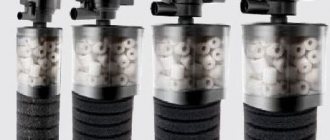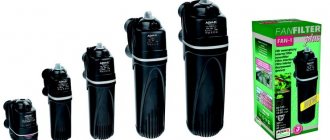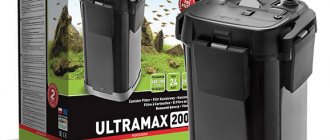by: fisher 12/11/2014 0 Comments
Filtration systems
Aquael
FAN series filters are ideal devices for beginner aquarists. They are easy to install and easy to maintain. All models in this series provide reliable filtration in freshwater aquariums from 3 to 250 liters.
The FAN series is represented by five models of internal filters : FAN MICRO, FAN MINI, FAN 1, FAN 2 and FAN 3.
The maximum performance of the internal filter is achieved when it is installed in the aquarium 3-4 cm below the water level. In the same position, complete aeration is ensured. It should be remembered that as a result of water evaporation, its level in the aquarium gradually decreases. This should be taken into account when choosing the filter .
The deeper the filter , the less efficiently its aeration occurs. The internal filter to the wall of the aquarium using suction cups. For fastening, you can also use the L-shaped holder included in the kit; it can be used either together with suction cups or separately.
The holder has a hole for attaching the aeration tube. It is important that its end is above the water level.
Some fish require current to create conditions close to natural in the aquarium. The strength of the current can be smoothly adjusted with a special handle without putting your hands deep into the water. It must be remembered that by reducing the strength of the flow, we reduce aeration.
The filter with various accessories. With their help, you can change the filter depending on your needs.
For effective aeration of water, the tube is connected on one side to an aeration nozzle, and on the other to an aeration regulator. The amount of air taken in is regulated by turning or turning the aeration regulator.
If a compressor is installed in the aquarium, the hose may not be used. In this case, the internal filter will operate absolutely silently.
To attach the suction cups, simply insert them into the holder-platform and turn them.
Thanks to the clever design of the perforated rod, dirty water coming from the aquarium is evenly distributed along the entire length of the sponge, rather than concentrated in its upper part.
The internal filter is especially interesting ; thanks to its design, it can work even at a depth of 3 cm. This feature makes this filter almost indispensable in terrarium pools, aquaterrariums and palludariums, where it can effectively purify water in conditions in which other filters do not work there will be.
FAN filter maintenance
Filter maintenance means timely cleaning of the rotor, rotor chamber and sponge. A filter that undergoes regular maintenance allows you to achieve ideal water clarity in the aquarium. To do this you need to follow simple rules.
Without periodic maintenance the filter becomes clogged, causing reduced water flow through the filter, reducing its performance.
When starting to clean the filter, you first need to unplug the plug from the electrical outlet. Then, with a slight movement, the filter is removed from the holder with suction cups and removed from the aquarium.
Next, disconnect the glass from the filter by lightly pressing it in the places indicated by the arrows in the figure.
Rinse the glass under running clean water.
Models FAN 2 and FAN 3 have a removable plastic pre-filter attached to the glass. It also needs to be washed to remove obvious contamination. The sponge removed from the perforated rod is washed in water drained from the aquarium approximately once a week, the frequency depends on the population density of the aquarium. The large-pored foam rubber from which the sponge is made effectively traps contaminants generated during the life of fish.
It is necessary to understand that this sponge functions not only as a mechanical, but also as a biological filter. On the surface of AQUAEL phenol-free sponges, ideal conditions are created for the life of beneficial nitrifying bacteria that oxidize ammonia and nitrites. Nitrifying bacteria are very sensitive to the presence of chemicals in water. That is why the sponge should be washed in water drained from the aquarium.
For normal life of bacteria, large amounts of oxygen are required. Therefore, a break in the operation of the filter lasting more than 3-4 hours, as a rule, leads to its complete sterilization (death of beneficial bacteria), as a result of which it will have to be washed and “started” again. It must be remembered that over time, sponges wear out without losing their appearance. Therefore, the filter material should be replaced with a new one at least once every six months.
Timely replacement of sponges has a positive effect on the efficiency of filtration and aeration in the aquarium.
The sponge should not be washed with tap water, as it is a habitat for nitrifying bacteria responsible for biological filtration. Tap water kills all beneficial bacteria.
Filters of the FAN plus series are powered by a sealed synchronous motor that does not require complex maintenance. However, approximately twice a month it is necessary to remove the bowl and rotor chamber cover, remove the rotor and carefully clean it and clean the rotor chamber.
After this, you should reassemble the filter in reverse order. After installing the rotor on the axis, it should rotate freely.
Internal organization
High reliability and long service life (on average 10 years) are ensured due to the simplicity of the internal structure of the filtration equipment.
An electric pump is located in a plastic cylindrical body to draw water through the holes. The liquid is passed under pressure through the filter material, and mechanical impurities are removed.
At the same time, biological treatment occurs. Colonies of saprophytes are formed in the cells of elastic polyurethane foam, which process organic matter.
An aeration tube with a nozzle and a regulator, in the absence of a compressor, will saturate the water with oxygen in the required concentration. The package includes accessories: when installed in different combinations, you can change the design of the filter and its functionality.
Aquael FAN has a regulator with which you can simulate flow in the aquarium. For some species of fish, its presence is an important condition for creating comfortable living conditions that are as close to natural as possible.
To adjust the flow strength, there is a manual regulator, the position of which can be changed without immersing your hands in the water. When using this function, the aeration intensity decreases, which should be taken into account when setting up the equipment.
The design of the perforated rod is made in such a way that the dirt contained in the processed water is distributed evenly over the entire area of the filter sponge. It is not concentrated only in its upper part.
Due to this, the efficiency of removing impurities increases. To reduce the level of vibration during operation of the equipment, the fixing suction cups of the powerful FAN 2 and 3 models are equipped with a shock absorber.
Additional accessories
Sponges.
Thanks to their large-porous structure, AQUAEL sponges do not lose their shape over time and look almost like new even after several months of use.
Over time, the filtration efficiency of such sponges decreases. The manufacturer recommends changing the filter media twice a year and using only branded sponges.
Suckers.
| Due to constant contact with water, rubber loses its elasticity, as a result of which the suction cups do not fit tightly to the glass, and therefore do not hold the filter . Therefore, they also need to be changed as they wear out - approximately once a year. |
For internal filters FAN2 and FAN3, special suction cups with a shock absorber are available to reduce filter vibration.
| To create a waterfall effect in the aquarium, with the murmur of water, you should use a special sprinkler nozzle (flute). Its use increases the efficiency of aeration and also promotes the uniform distribution of purified water in the aquarium. | |
| Two models of flutes are produced: one for internal filters FAN micro, FAN mini, FAN1, FAN2, and the other for FAN3. |
Equipment and necessary additions
The basic set of the device consists of a glass, a porous sponge, a pump, a flow power regulator and a suction pad. Based on the requirements for functionality, an aeration tube with a nozzle and a regulator, a deflector, holders, and suction cups can be used.
Flute and similar accessories
- To achieve a waterfall effect while the Aquael filter is operating, it is proposed to use a flute - a nozzle, when passing through which the drops fall like rain.
- It helps to more evenly distribute the purified liquid in the container and further aerate it.
Suction cup holders
- 4 suction cup holders ensure reliable fixation of the device on the glass surface. They are made of high quality rubber and are inserted into a holder platform.
- Despite constant contact with water, the device lasts a long time. The product life is sufficient for 1 year of operation.
Inner jaws
To remove mechanical impurities and biological purification of water, a phenol-free sponge with large pores is used.
Due to this structure, optimal conditions are provided for the life of nitrifying bacteria, which oxidize nitrites and ammonia during their life.
During operation of the system, it is necessary to take into account the sensitivity of microorganisms to chemicals.
Mini UV Sterilizer
The water flowing through the sterilizer is exposed to short-wave ultraviolet radiation (UV-C). Which kills pathogenic bacteria, tiny algae and other simple microorganisms living in aquarium water. It is recommended to turn on the sterilizer for prevention once a week for several hours, and also as needed (for example, in the event of mild turbidity caused by protozoa or fish diseases).
The mini sterilizer is installed on the filter . There are four ultraviolet LEDs inside the sterilizer. Ideal for FAN micro, FAN mini, FAN1 filters The sterilizer is easy to install and does not require additional maintenance. It has an autonomous power supply, allowing you to turn it on as needed.
Multi UV Sterilizer
for internal filters FAN 2 and FAN 3. This device is small in size and simple in design. A 3-watt light bulb is built into one of the modules (there are 4 of them in the set - for each type of compatible filter). When used with filters , the MULTI UV module is installed between the filter head and the sponge cup. The device does not require additional maintenance, and the lamp life is 5000 hours (after which it must be replaced).
Instructions for installing a filter in an aquarium
Installation of equipment is necessary before you start using it and after weekly maintenance of the system. When installing Aquael, it is recommended to consider the following factors:
- Immersion depth. The optimal location of the filter is 3-4 cm below the surface. This makes it possible to ensure full aeration and maximum productivity. As depth increases, the efficiency of water saturation with oxygen decreases.
- Fastening. When mounting on a wall, for greater reliability, it is worth using suction cups and an L-shaped holder at the same time. They can be used separately if installation conditions do not allow another option.
- Location of the aeration tube. It should be above the surface of the water. There is a regulator to regulate the level of oxygen supply. When using a compressor, the hose may not be installed.
Depending on the required functionality of the equipment, additional components are installed, for example a flute. After this, the operating parameters of the device are configured.
Possible malfunctions and methods for eliminating them
| Types of faults | Possible reasons | Elimination methods |
| The filter does not work when plugged into the mains. | The electrical wire is damaged, the motor winding is burned out | Replace the filter |
| The filter does not work or works intermittently when plugged into the mains. | Contamination of the rotor chamber, rotor, rotor axis. Lime deposits on rotor chamber parts, rotor sticking | Open the cover of the rotor chamber, pull out the rotor, wash the rotor chamber, rotor axis, rotor. If there are lime deposits, remove them using a special tool. funds. Place the rotor in place, turn 2-3 turns (the rotor should rotate easily on the axis) |
| The filter works, but the water comes out in a weak stream | 1.water flow power is not adjusted 2.Filter parts are clogged | 1.Increase the flow power using the power regulator. 2. Disassemble the filter, wash or replace the sponge, remove and clean the rotor |
| The filter works, but there is little or no air aeration | 1. Water flow regulator is set to minimum 2. Air flow regulator is set to minimum 3. Aeration nozzle or hose is clogged 4. Filter is installed at a depth of more than 3 cm from the water surface 5. Filter sponge and filter parts are clogged | 1.adjust the strength of the water flow 2.Adjust the strength of the air flow. 3.clean the aeration nozzle (using a needle) or the air supply hose. 4.install the filter closer to the water surface (3cm) 5.rinse or replace the filter sponge, rinse the rotor and rotor chamber |
| A squelching sound is heard when the filter is used with the aeration nozzle. | The plug on the air flow regulator is not installed. | Install the plug and adjust the air flow. |










